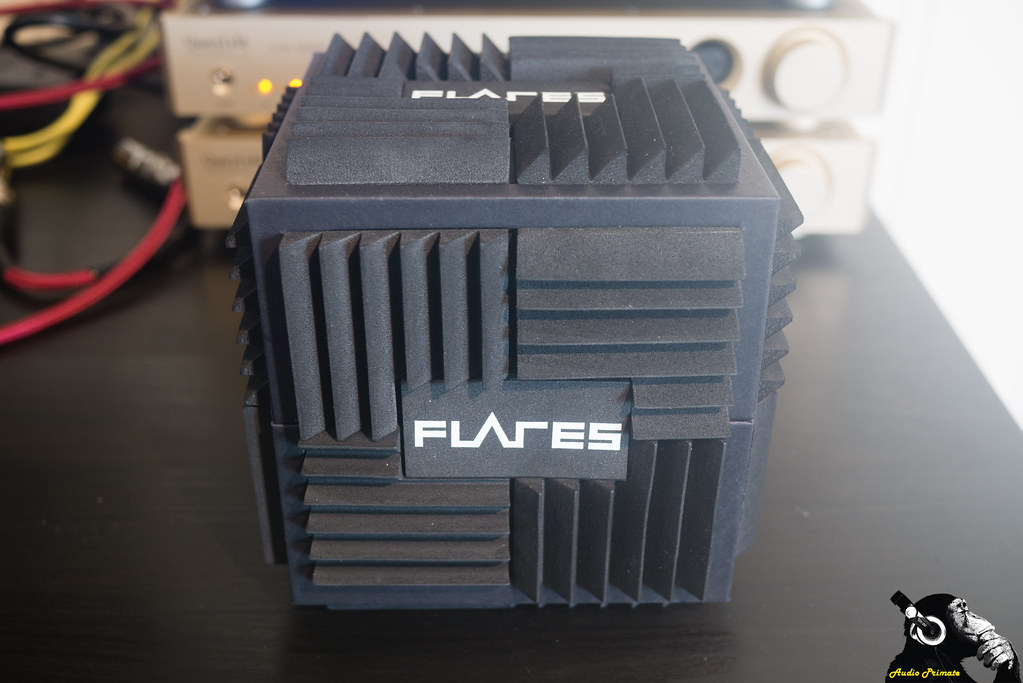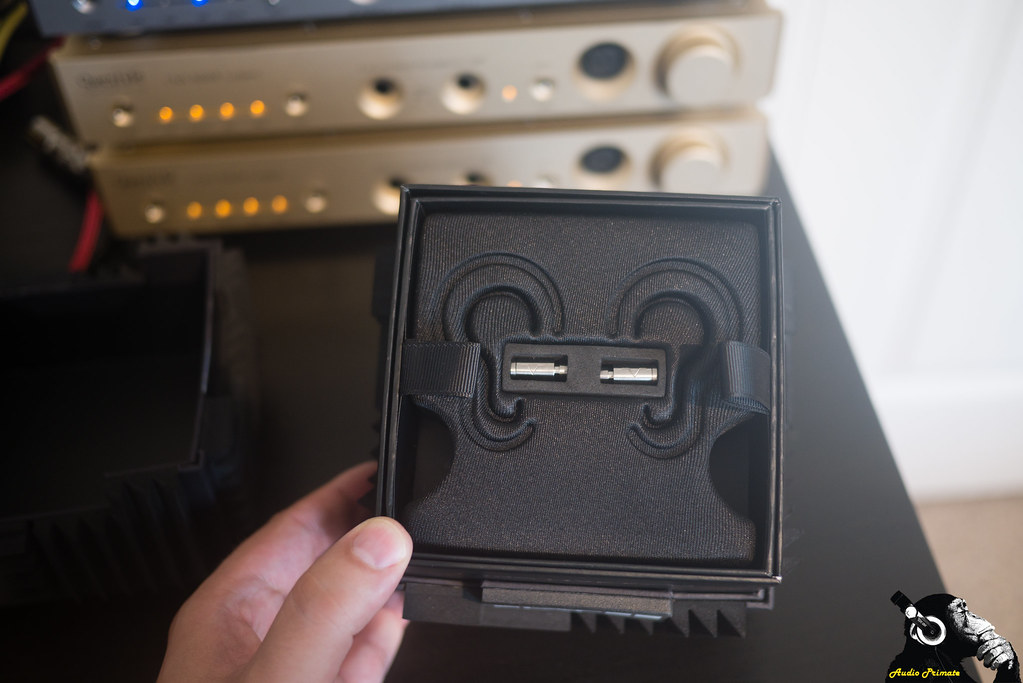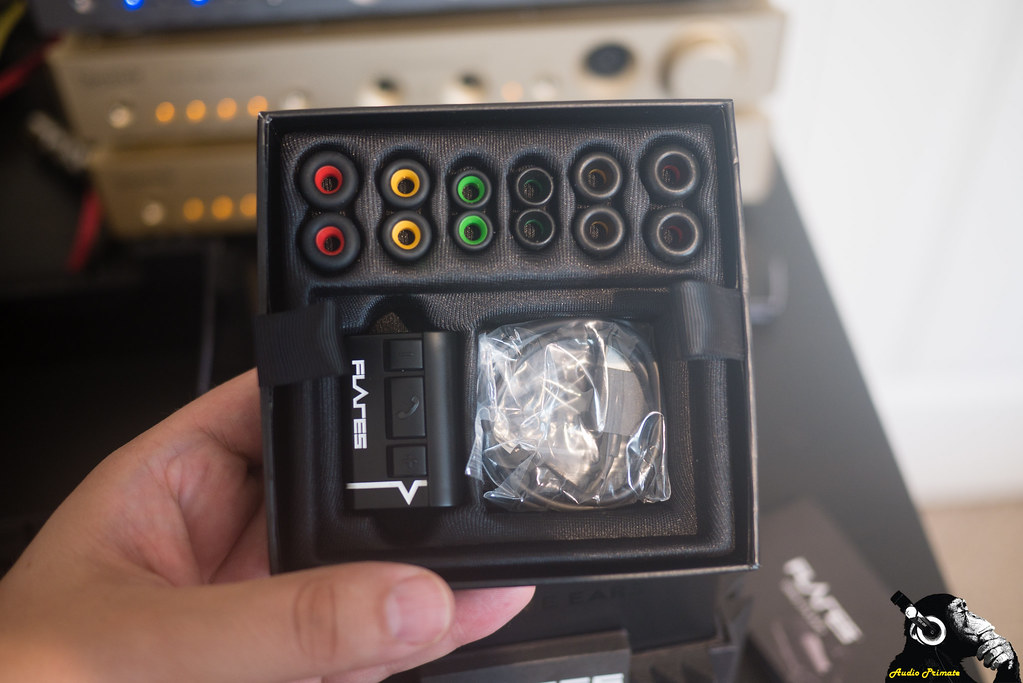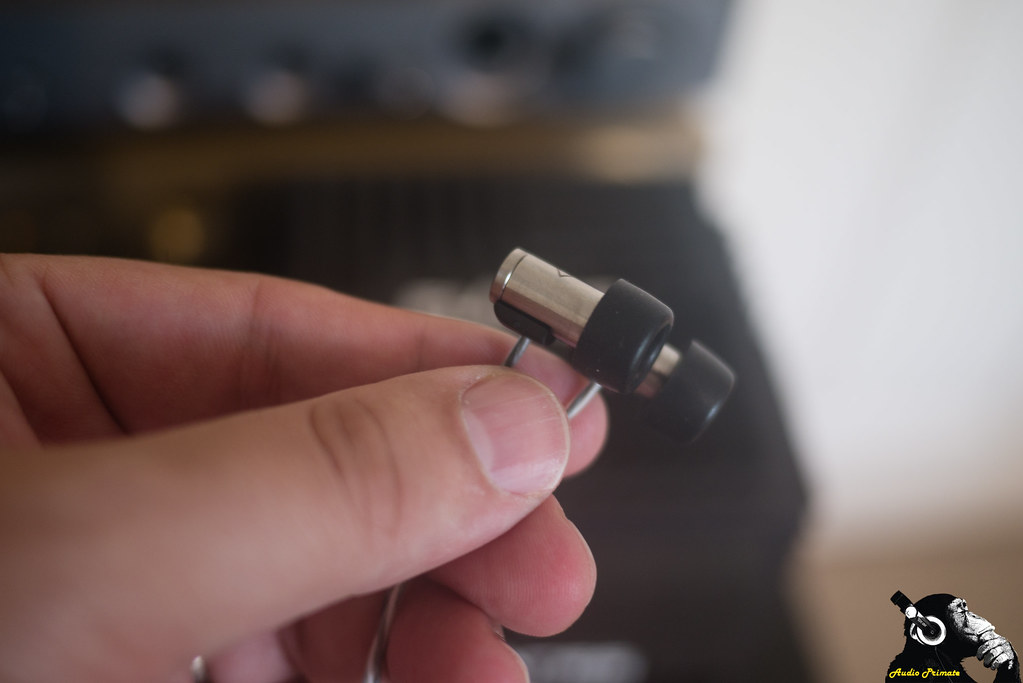Pros: Extraordinarily clear in Bluetooth, excellent resolution and speed, accurate timbre, black background, completely non-fatiguing, tiny and comfortable, cool packaging, super ergonomic tips, great Bluetooth range and battery life
Cons: rolled off sub-bass, microphonic cable, USB micro, prone to electrical interference in Bluetooth, ugly poor quality cables
List Price: £349 ($399)
Product Website: https://www.flareaudio.com/products/flares

Rating Disclaimer: ratings are subjective. Audio quality and value do not mean the same thing across all prices. A headphone with a 5 rating on audio at $5 does not have equivalent sound quality as a 5 rating at $500. Likewise, value at $5 is not the same as value at $5000 dollars.
Introduction
I approached Davies Roberts because I saw him around headphone groups on Facebook, and thought his technology sounded pretty cool. The idea behind the Flares Pro is to eliminate all resonance in the chamber and to expand the soundstage by directing sound in the most direct way to your inner ear.
Usability: Form & Function
Unboxing
The Flares Pro have a cool box. It’s a cube made of an acoustic foam like material. The box had to go through prototyping stages and extensive design. That’s some serious packaging. I love it. For full details of the unboxing experience, check out my Youtube unboxing video below.
The box is loaded up and lives up to the outer packaging on the inside too, with formed inserts with nice texture and layers of trays. It’s like getting a care package from family half a world away, just layers of goodness piled on top of each other.
Aesthetics
The box wins the awards on aesthetics. These headphones never will. They aren’t ugly, but they definitely subscribe to the function defines form mantra. The IEMs are made of titanium and nicely machined with precision everywhere. The cables have four wires altogether (2 on each channel), with the right side being white and grey and the left side being black and grey. The cables are attached via MMCX terminations to either the Flares DAC/Amp/Bluetooth unit or the y-split of the wired unit. A balanced cable was in development last I heard. The wired connector is terminated in a 3.5mm single ended cable with 4 wires running into the connector.

I told Davies that I would have done the wired connection differently. I would have had a balanced connector in the y-split to allow flexibility on amp termination by just switching a small length of cable. A locking 2.5mm connector would have done the trick from a security and size perspective. I would have put MMCX connectors at the headphone end and provided the Bluetooth module fully wired. The Bluetooth module is also quite large. Given that balanced does sound better with the Flares Pro, this would have been a positive.


Ergonomics
The Flares Pro are very comfortable to wear. In the ear they are slim, and some clever design of the Flares Earfoams has allowed me to avoid a problem that I’ve had with many eartips. Many eartips overlap the bend in the ear because they are too long. Flares Earfoams are about half the height of normal eartips. They can be worn two ways: with the tips past the bend, or before the bend; either way prevents pressure build up. Either way of wearing the Flares Pro also requires perfect seal to get the best sound. So if the sound is thin, you need to re-seat your tips, chances are you’ve had one of the tips bend a little bit. Inserting straight into the ear is the best path to good fit. If you want to get deeper, you can always tug on the top of your ear whilst inserting. Wiggling in a circle once all the way in helps with seal, also.

There are two types of special Earfoams included with the Flares Pro and one set of Comply style earfoams for people who just want what they are used to. Here is a breakdown of the Earfoams.
| Earfoam | Material | Comfort | Durability | Seal | Sound |
| Audiophile | Microfoam | Excellent | Very fragile | Excellent | Slightly warm, open |
| Everyday | Silicone | Excellent | Very durable | Finicky, may need reseat | Neutral, open |
| Universal | Comply style foam | Good | Just like Comply | Good | Warm, closed |
I preferred the Everyday Earfoams. The Universal’s were the worst as they don’t take advantage of one of the key design features of the Flares Pro, the Acoustic Lens. The Acoustic Lens basically removes resistance and reflections on the way to your eardrum by having a cone extend from the driver inside the IEM. The Audiophile and Everyday Earfoams continue this cone with the furthest point on the eartip having the widest aperture. This essentially means that the sound is being beamed at your eardrum with very little to impede it. In my experience this made the soundstage bigger and more realistic. The Universals just have a tube at the end.
The Audiophile Earfoams are Davies’s favourites, but about half his office prefers the Everyday Earfoams like me. I think this might be partly due to the fragility of the Audiophile Earfoams. The foam is very prone to tears so if you are switching between the Everyday and Audiophile Earfoams, it is necessary to be very careful. Wiggle gently and slowly with your fingernails anchoring underneath those earfoams.
The cable included with the Flares Pro is a bit long (in corded mode) and quite microphonic. A softer outer material probably would have helped lower the microphonics. Many headphones can have microphonics reduced by wearing them with the cable over the ear. Doing this requires using the chin-cinch on the cable.

Isolation with the Flares Pro is fair, as they are basically open back.
I’ve not experienced any stapedius reflex with the Flares Pro. They are comfortable to play at pretty decent volumes for long periods of time. The Flares Pro have never caused me to have any ear fatigue. I can listen as long as I want, which is good, because I like listening to them a lot.
Build quality
The titanium housing on the IEM looks bombproof. The strain relief does not on any termination of the cable. There is basically no strain relief at the housing, no strain relief extending from the MMCX plug, and no strain relief at the 3.5mm jack. The Flares Pro doesn’t believe in strain relief or fully detachable cables. One of the previous complaints of the Flares previous line-up of headphones was that the cables regularly broke at the earpiece. This concern of customers does not appear to have been heeded. The cable should have been implemented better.
The Bluetooth module has good firm connections for the MMCX and the buttons press nicely. I had no problems navigating the controls. The module itself is made of a good thick plastic. It looks durable, but I’ve not tried to kick its butt. On the rear of the Bluetooth module there is a shirt clip. When in Bluetooth mode, this will help with the microphonics of the cable also.
I do have a couple minor niggles with the Bluetooth module: the USB micro connector was stupidly shortsighted and it’s a bit bulky. Last year it was fairly apparent that basically everything was moving towards USB-C, the part switch should have been done. There is also the matter of the claims Flare Audio is making about being a 24/96 DAC. First, aptX is 16/44, so it doesn’t matter what the DAC chip is capable of in Bluetooth mode. Second, I tried plugging it into my phone via USB OTG cable and it is not recognized as a DAC, so this claim is 100% misleading.

Bluetooth Functionality
Battery life was pretty good on the Flares Pro, tipping in at approximately 12 hours. The Bluetooth range was also excellent. I easily got 10 meters of range in my office from any source I used. I did run into a problem with interference and cut-outs, but the problem is very specific. I work near the intersection of several tram lines. There are a butt-ton of wires running overhead. In this area I get choppy, unlistenable reception. I don’t know if the problem is electrical noise or something else, but the Flares Pro are hopeless in this area. When testing with other wireless in-ears, I also had problems, but the Flares are some of the worst in this specific place on earth. Brilliant elsewhere, but not in Piccadilly Gardens. I haven’t tested in the London Underground, DLR, or Overground, but I can imagine they may have difficulties there also.

Audio quality
The Flares Pro have a slightly mid-centric sound with some significant roll-off in the sub-bass region. This isn’t completely unexpected as the driver is absolutely miniscule and is open back. There is a touch of warmth to the sound, and good openness and details in the sound. I have never felt any fatigue with the Flares Pro sound.
They have natural mids and extended treble. There is excellent coherence and the sound is devoid of unnatural resonance. If these had more sub-bass, it would feel like being at a small show in a coffee shop. There is excellent realism and natural timbre. The stage isn’t very big, but that isn’t expected from a tiny microdriver. The Flares Pro do not cause any stapedius reflex (stiffening of you ear muscles that causes hearing damage), as they are basically an open design that distributes sound across your whole eardrum using their acoustic lens technology. I used these as my daily driver for a long time at work, in spite of a big review queue.

Pairings
I tried the Flares Pro with my Azus Zenfone 3 phone (wired & Bluetooth), my new LG V30 phone, the Audio Opus Opus #3 (wired 2.5mm balanced/3.5mm & Bluetooth), the Questyle QP2R (with and without iFi iEMatch, in 2.5mm balanced and in 3.5mm), and I tried with some big amps like the Questyle CMA600i and the XIAUDIO Formula S.
Don’t do big amps. The sound warms up and so do the IEMs—I mean the temperature of them gets hot. I’ve experienced this effect when over-driving IEMs before with the oBravo ERIB-2A and some RHA metal-shelled IEMs. These Flares Pro will also clip when fed too much power, so be careful out there or you’ll damage your sweet-ass Flares Pro. The Questyle QP2R gives these more than they can handle and causes these to distort in what sounds like potentially damaging ways.
If you haven’t had a custom balanced cable made, which isn’t too hard for these as the standard cable is wired in a balanced configuration, it just has a single-ended plug; then Bluetooth provides as good or better sound as single-ended on most sources. In Bluetooth, these sound better than many mid-tier headphones. Davies told me to challenge them against anything, so I tried against the HiFiMAN Susvara, Noble Encore, UERR, and more. I thought all those competitors were better, unsurprisingly. These are excellent, though.
The main downfall of Bluetooth usage is that some treble notes can sound thin and a bit stiff, especially cymbals. I compared these a bit to RHA’s excellent MA750 wireless and found that RHA appeared to have a bit of DSP applied to the same treble notes to make them a little fuller, which tells me that more may be possible out of the Flares Pro in Bluetooth mode than it is currently accomplishing.
Comparisons
For simplicity, I limited comparisons to the UERR (partly to have a neutral reference) and the RHA MA750 Wireless. The source was the Audio Opus Opus #3, as the Opus 3 has fairly neutral characteristics and good Bluetooth implementation. As I do not have a Bluetooth cable for the UERR, comparisons were done with the custom prototype 2.5mm balanced cable that was provided by Flare Audio. I recognise that Davies Roberts hasn’t made an official version of this cable, which is a damn shame, because when he claimed to me that cross-talk was the enemy of his Flares Pro, he was right. The Flares Pro do take a step forward in balanced implementation and he should remedy his error in not releasing a balanced cable in the year since the release of the Flares Pro. This also applies to the new Flares Gold, the £999 upgrade to the Flares Pro that happens to have the same single-ended cable, and same Bluetooth module.
Volume matching was done using an SPL meter with a home-made IEM coupler. The source material was white noise, as I find that it provides the most reliable volume matching for me. My listening level is approximately 78.2dB using Ayre Acoustics’ Irrational but Efficacious System Enhancement Disc. All volume matching data is in the table below. I present this so that you can replicate my findings if you so choose. For Bluetooth, the volume on the headphone side was set to max, and the Opus #3 was used for volume control. This functions a bit like a pre-amp and power amp setup.
| Headphone | Cable | SE/Balanced | Gain | Volume | ~SPL |
| Flares Pro | Balanced Prototype | Balanced | High | 97 | 78.2 |
| Flares Pro | Stock | SE | High | 101 | 78.3 |
| Flares Pro | Bluetooth | — | High | 51/Max | 78.1 |
| RHA MA750 Wireless | Bluetooth | — | High | 28/Max | 78.3 |
| UERR | Stock Balanced | Balanced | High | 98 | 78.1 |
UERR vs. Flares Pro
Davies Roberts recommended that I give a listen to John Lennon – Imagine to listen for the string section coming in. I have to say, though, the original vinyl/CD/SACD versions (I’ve listened to them all) are not terribly good sounding. The Mobile Fidelity Sound Lab (MFSL) CD version sounds pretty special, though, so I’ve got that one on.
The Flares Pro has greater fluidity to the sound than the UERR running in balanced mode out of the Opus #3. On Imagine, John Lennon’s voice is more lush and inviting than on the UERR. The UERR has deeper bass extension, and bass quantities are similar. The soundstage on the UERR extends deeper wider and taller than the Flares Pro. The timbre of piano ono the Flares Pro is bit better, with a fuller sound, while the UERR sounds a bit brittle. From a timbral perspective, both are excellent. Instruments sound as they should without much imposition of colour onto the sound. The Flares Pro has a tiny bit of what could be termed extra warmth in the mids (that hint of lushness), but whether you think that is extra probably has more to do with what you are used to listening to than what is ‘neutral.’
For live recordings, there isn’t much better than Talking Heads – Psycho Killer off Stop Making Sense. The track has remarkably clear demarcations of the players in the stage and a good mix of artificial and natural sounds with a totally transparent black background. It’s a fab recording. David Byrne’s vocals are a bit smoother on the Flares Pro, and a little more impactful and tight on the UERR. There’s a touch more distance back in the stage on his vocals on the Flares Pro, which could indicate a slight dip in this part of the frequency response. As with Imagine, the soundstage is smaller in all dimensions. The UERR has a more holographic stage. Both present a very clear image with excellent separation. On the Flare Audio website, there are several celebrity producer endorsement that say stuff to the effect of ‘I’d master with these.’ I can see it. They are basically neutral with a little bit of sub-bass roll-off.
At this point I’m craving some speed and aggression. Lets see what Metallica – Master of Puppets does for me. With the Flares Pro there is a touch of softness in the mids. I’m missing some aggressive crunch in the guitars and a little punch in the drums. Could be that I normally listen to this track louder. Loudness = dynamics. The UERR sounds more focused in the mids, which maintains a bit more of the vocal aggression and crunch, as well as drum punch. The Flares Pro are a more relaxed listen.
For treble I often use Kraftwerk – Kometenmelodie 2 to see if the notes go as shrill as they should be. I’m actually testing for the edge of cacophony. On this track, both pairs of IEMs hit about the same high note, but the body of that note is a little fuller on the UERR. The UERR does a better job representing the high treble notes in this track. The UERR stage, unsurprisingly with superior treble, is also larger.
After doing my wireless comparison, I decided to go back and test the UERR vs. the Flares Pro in Bluetooth, so I threw on Billy Cobham – Quadrant 4 and let ‘er rip. Cymbals have a bit more accurate body, attack and decay on the UERR vs. the Flares Pro (in Bluetooth). I get a lot more natural and fluid cymbal notes on the UERR. Both do a good job of capturing the speed of the guitar solo about 1 minute into the track, but the UERR has the edge in resolution. The Flares Pro mostly keep up which is pretty impressive for a Bluetooth headphone. The Flares Pro still sounds comparatively soft in the mids to the UERR.
RHA MA750 Wireless vs. Flares Pro
On Kometenmelodie 2 the Flares Pro is clearer with a more neutral tone. The drum thumps louder on the RHA MA750 Wireless because it has some emphasis in the bass drum area of the frequency response. The tone sounds muffled in comparison with the RHA MA750 at volume matched levels. The difference in stage depth is immediately noticeable. Both do a good job at representing a relatively wide stage. The Flares Pro has superior stage height. The sound just feels right out of the Flares Pro on this track compared to the RHA MA750 Wireless.
I think that the wireless setup may sound a bit better than the wired setup, even in balanced mode on the Flares Pro. The stage feels like it has more height and the violins on Imagine more emotional weight. It could be that the amplification and signal processing are a perferct match with the drivers on the Flares Pro. On the MA750 Wireless the sound stage is a touch wider and bass has more emphasis. The violins lack the sharp incisiveness of the Flares Pro and the sound is less balanced due to the bass emphasis. Stage height isn’t as tall as the Flares Pro, but is good. Stage width is very impressive at £150.
As previously mentioned, one of the weaknesses that me and some others have commonly observed in Bluetooth headphones is thinness or tinnyness in cymbal strikes, so I decided to test this out with Billy Cobham – Quadrant 4 which has lots of cymbal strikes. The RHA MA750 Wireless sound pretty engaging, but they lose on micro-details on the speedy cymbal tapping in this track to the Flares Pro. The Flares Pro is clearer, with a far blacker background. Instruments have more distinct placement, especially on the percussion and guitar. The instrument separation within the stage is far superior on the Flares Pro. The cymbals sound good, not too thin on either of the in-ears, but the resolution on the Flares Pro far outshines the MA750 Wireless on this challenging track.
With regards to Bluetooth performance, the RHA M750 Wireless is superior. It has just as much range, and just as much battery life, but it doesn’t have as much problem with electrical interference. I find the neckband of the RHA MA750 wireless more comfortable and convenient than the clip design of the Flares Pro. USB-C is appreciated on the RHA MA750 Wireless, because it allows me to have one cable to charge my headphones and source(s). Both are fast connections to my LG V30.
Specifications
| Specifications | |
| Price | $399 (£349) |
| Bluetooth specs | 15m range (confirmed), 12hr playback (confirmed), v 4.1 with aptX, dongle includes balanced class A-B amplification and 16/96 capable DAC, 15 step volume control |
| Driver | 5.5mm beryllium driver |
| Build | Grade 5 titanium housing, hardwired left and right cables with MMCX terminations, OFC copper cable |
| Accessories | Audiophile Earfoams (S/M/L), Everyday Earfoams (S/M/L), Universal Earfoams (S/M/L), Wireless DAC, |
Acknowledgment
The Flares Pro were provided without charge by Flare Audio. I have not been compensated for this review. The Flares Pro are not my property and will be returned to Flare Audio upon request.
Conclusion
The Flares Pro are pretty special in their audio presentation as a Bluetooth headphone. They compete or beat many wired headphones at the same price level. While the distance between them and the UERR sounds pronounced in this review, in normal non-critical listening, the difference isn’t that big. These aren’t giantkillers, but if you want the best sounding aptX Bluetooth headphones on the market, these have a good chance of being them. When LDAC Bluetooth begins to dominate the market in the next year or so, these might not be the best anymore. Flare Audio would do well to see if the chip they use is compatible and move forward with implementing LDAC and or aptX-HD.
With regards to the rest of the total package, the package and accessories are absolutely premium. The box is insanely cool, though probably nowhere approaching cost effective to produce—could we have these for £300 with a more utilitarian box? The Bluetooth has excellent range and battery life. The build quality, outside of the driver and capsule, is pretty sad. I’ve heard plenty of stories of cables breaking.
Bottom line: if you want an extremely black background, exceptional clarity, and a neutral (slightly warm) tone that just sounds right and never fatigues in a Bluetooth headphone these are worth the price of admission.



Leave a comment